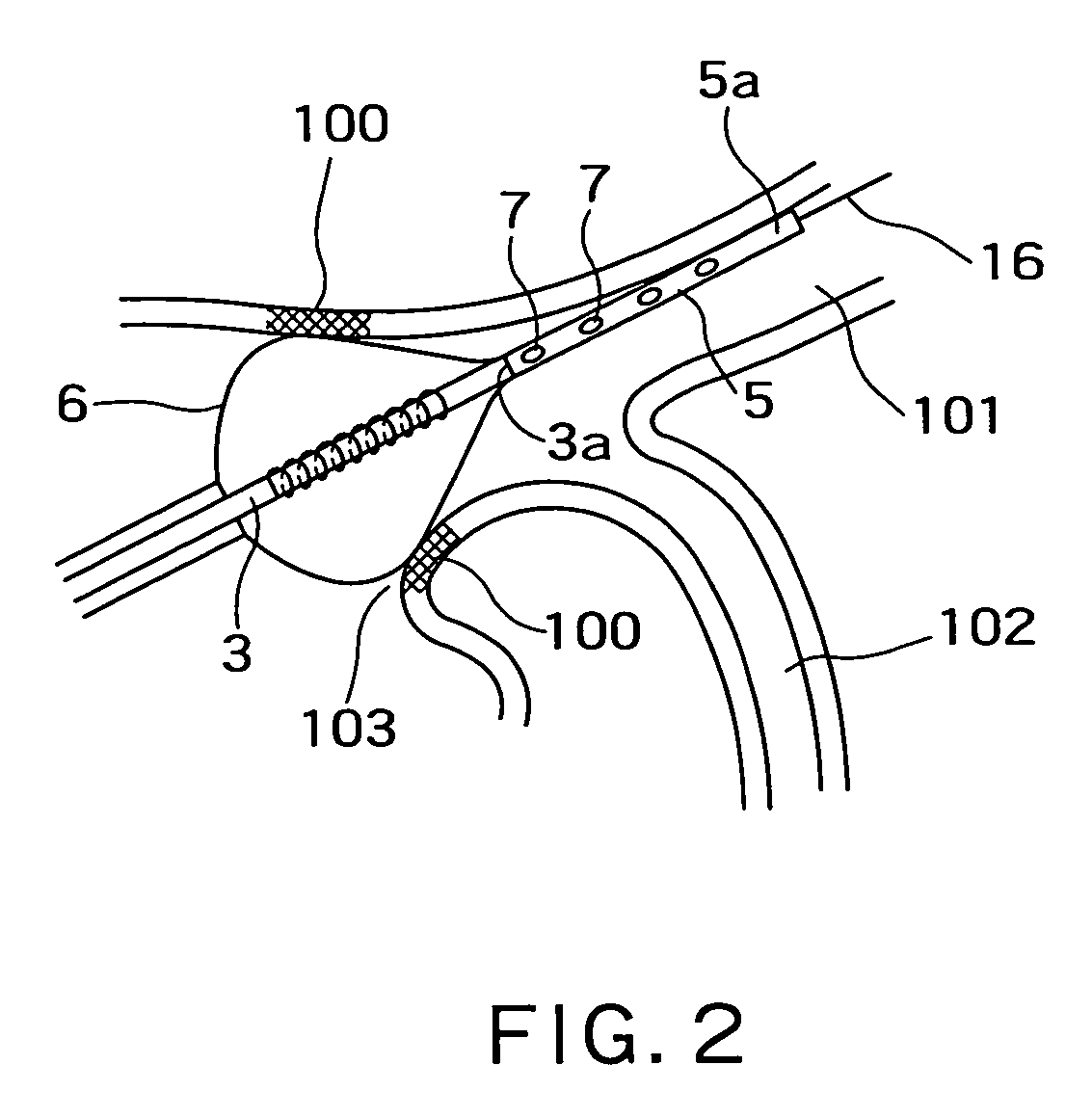Radio-frequency heating balloon catheter
a radiofrequency heating and catheter technology, applied in the field of radiofrequency heating balloon catheters, can solve the problems of stenosis of the pulmonary vein, high time-consuming and laborious, and achieve the effect of safe cauterizing the atrial vestibul
- Summary
- Abstract
- Description
- Claims
- Application Information
AI Technical Summary
Benefits of technology
Problems solved by technology
Method used
Image
Examples
first embodiment
[0041]The basic construction of a radio-frequency heating balloon catheter 1 in a first embodiment according to the present invention will be described with reference to FIG. 1. The radio-frequency heating balloon catheter 1 will be described as applied to the treatment of a lesion in the left atrial vestibule 103. Naturally, the radio-frequency heating balloon catheter 1 is applicable to the treatment of a lesion in the right atrial vestibule.
[0042]Referring to FIG. 1, the radio-frequency heating balloon catheter 1 comprises a catheter tube 4 including an outer tube 2 and an inner tube 3 slidable relative to the outer tube 2, an inflatable balloon 6 of a shape capable of coming into contact with a target lesion 100 in the left atrial vestibule 103 when inflated, a radio-frequency electrode 8 disposed inside the balloon 6, a lead wire 10 electrically connected to the radio-frequency electrode 8, a thermocouple 12 placed in the balloon 6 to sense temperature in the balloon 6, a guide...
second embodiment
[0059]In a conventional radio-frequency heating balloon catheter, an electrode placed in a balloon heats a liquid contained in the balloon ununiformly and thermal convection of the liquid occurs in the balloon. Consequently, the temperature distribution in the balloon unavoidably, becomes irregular and hence tissues in contact with the balloon cannot uniformly be heated. The radio-frequency heating balloon catheter 1 in the second embodiment is provided with a stirring mechanism 14 to stir the liquid contained in the balloon 6 so that the liquid contained in the balloon 6 may uniformly be heated so that tissues in contact with the balloon 6 can be hated as uniformly as possible by radio-frequency heating. As mentioned above, since high radio-frequency power is supplied to the balloon to cauterize the open ends of the pulmonary veins 103 and 106, the temperature distribution in the balloon 6 tends to be un-uniform. Therefore, the stirring mechanism 14 is very effective in making the ...
third embodiment
[0094]A balloon catheter 1 in a third embodiment according to the present invention will be described with reference to FIG. 6. The balloon catheter 1 is provided with a stirring mechanism 80 for stirring a liquid contained in a balloon 6 to make temperature distribution in the balloon 6 uniform.
[0095]The stirring mechanism 80 includes a connecting pipe 82 communicating with a passage 83 defined by an outer tube 2 and an inner tube 3, and a vibration-generating device 81, such as a vibration-generating pump, capable of vibrating the liquid filling up the connecting pipe 82 and the passage 83. The connecting pipe 82 branches from the outer tube 2. The liquid fills up the connecting pipe 82, the passage 83 and the balloon 6. When vibrations of, for example, 1 Hz generated by the vibration-generating device 81 is applied to the liquid, an oscillatory wave 86 propagates through the liquid filling up the connecting pipe 82 and the passage 83. Consequently, random swirling currents 85 are...
PUM
 Login to View More
Login to View More Abstract
Description
Claims
Application Information
 Login to View More
Login to View More - R&D
- Intellectual Property
- Life Sciences
- Materials
- Tech Scout
- Unparalleled Data Quality
- Higher Quality Content
- 60% Fewer Hallucinations
Browse by: Latest US Patents, China's latest patents, Technical Efficacy Thesaurus, Application Domain, Technology Topic, Popular Technical Reports.
© 2025 PatSnap. All rights reserved.Legal|Privacy policy|Modern Slavery Act Transparency Statement|Sitemap|About US| Contact US: help@patsnap.com



